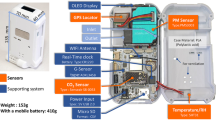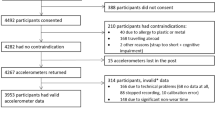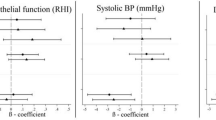Abstract
Air pollution intake represents the amount of pollution inhaled into the body and may be calculated by multiplying an individual’s ventilation rate with the concentration of pollutant present in their breathing zone. Ventilation rate is difficult to measure directly, and methods for estimating ventilation rate (and intake) are lacking. Therefore, the goal of this work was to examine how well linear models using heart rate and other basic physiologic data can predict personal ventilation rate. We measured personal ventilation and heart rate among a panel of subjects (n = 36) while they conducted a series of specified routine tasks of varying exertion levels. From these data, 136 candidate models were identified using a series of variable transformation and selection algorithms. A second “free‑living” validation study (n = 26) served as an independent validation dataset for these candidate models. The top‑performing model, which included heart rate (Hr), resting heart rate (Hrest), age, sex, and hip circumference and interactions between sex with Hr, Hrest, age, and hip predicted ventilation rate (Ve) to within 11% and 33% for moderate (Ve = 45 L/min) and low (Ve = 15 L/min) intensity activities, respectively, based on the validation study. Many of the promising candidate models performed substantially worse under independent validation. Our results indicate that while measures of air pollution exposure and intake are highly correlated within tasks for a given individual, this correlation decreases substantially across tasks (i.e., as individuals go about a series of typical daily activities). This discordance between exposure and intake may influence exposure‑response estimates in epidemiological studies. New air pollution studies should consider the trade‑offs between the predictive ability of intake models and the error potentially introduced by not accounting for ventilation rate.
This is a preview of subscription content, access via your institution
Access options
Subscribe to this journal
Receive 6 print issues and online access
$259.00 per year
only $43.17 per issue
Buy this article
- Purchase on Springer Link
- Instant access to full article PDF
Prices may be subject to local taxes which are calculated during checkout





Similar content being viewed by others
References
Künzli N, Kaiser R, Medina S, Studnicka M, Chanel O, Filliger P, et al. Public-health impact of outdoor and traffic-related air pollution: a European assessment. Lancet. 2000;356:795–801.
Brunekreef B, Holgate ST. Air pollution and health. Lancet. 2002;360:1233–42.
Pope CA 3rd, Burnett RT, Thurston GD, Thun MJ, Calle EE, Krewski D, et al. Cardiovascular mortality and long-term exposure to particulate air pollution: epidemiological evidence of general pathophysiological pathways of disease. Circulation. 2004;109:71–7.
U.S. EPA. Integrated science assessment (ISA) for oxides of nitrogen – health criteria (final report, 2016), EPA/600/R-15/068. Washington, DC: US Environmental Protection Agency; 2016.
U.S. EPA. Integrated science assessment (ISA) of ozone and related photochemical oxidants (final report, 2013), EPA/600/R-10/076F. Washington, DC: US Environmental Protection Agency; 2013.
U.S. EPA. Integrated science assessment for particulate matter, EPA/600/R-08/139F. Washington, DC: US Environmental Protection Agency; 2009.
Lioy PJ. Assessing total human exposure to contaminants - a multidisciplinary approach. Environ Sci Technol. 1990;24:938–45.
Monn C. Exposure assessment of air pollutants: a review on spatial heterogeneity and indoor/outdoor/personal exposure to suspended particulate matter, nitrogen dioxide and ozone. Atmos Environ. 2001;35:1–32.
Duan N, Dobbs A, Ott W. Comprehensive definitions of exposure and dose to environmental pollution, SIMS technical report no. 159. Stanford, CA: Department of Statistics, Stanford University; 1990.
Zhang JJ, Lioy PJ. Human exposure assessment in air pollution systems. ScientificWorldJournal. 2002;2:497–513.
Sheppard L, Burnett RT, Szpiro AA, Kim SY, Jerrett M, Pope CA 3rd, et al. Confounding and exposure measurement error in air pollution epidemiology. Air Qual Atmos Health. 2012;5:203–16.
Zeger SL, Thomas D, Dominici F, Samet JM, Schwartz J, Dockery D, et al. Exposure measurement error in time-series studies of air pollution: concepts and consequences. Environ Health Perspect. 2000;108:419–26.
Samet JM, Lambert WE, James DS, Mermier CM, Chick TW Assessment of heart rate as a predictor of ventilation. 1993.
U.S. Environmental Protection Agency. EPA methods for derivation of inhalation reference concentrations and application of inhalation dosimetry, EPA/600/8-90/066F. Washington, DC: Office of Research and Development, Office of Health and Environmental Assessment; 1994. .
Cole-Hunter T, Morawska L, Stewart I, Jayaratne R, Solomon C. Inhaled particle counts on bicycle commute routes of low and high proximity to motorised traffic. Atmos Environ. 2012;61:197–203.
Greenwald R, Hayat MJ, Barton J, Lopukhin A. A novel method for quantifying the inhaled dose of air pollutants based on heart rate, breathing rate and forced vital capacity. PLoS ONE. 2016;11:e0147578.
Ramos CA, Reis JF, Almeida T, Alves F, Wolterbeek HT, Almeida SM. Estimating the inhaled dose of pollutants during indoor physical activity. Sci Total Environ. 2015;527-528:111–8.
Zuurbier M, Hoek G, van den Hazel P, Brunekreef B. Minute ventilation of cyclists, car and bus passengers: an experimental study. Environ Health. 2009;8:48.
Piwek L, Ellis DA, Andrews S, Joinson A. The rise of consumer health wearables: promises and barriers. PLoS Med. 2016;13:e1001953.
Soucie LP, Carey C, Woodend AK, Tang AS. Correlation of the heart rate-minute ventilation relationship with clinical data: relevance to rate-adaptive pacing. Pacing Clin Electrophysiol. 1997;20(8 Pt 1):1913–8.
Aitken ML, Franklin JL, Pierson DJ, Schoene RB. Influence of body size and gender on control of ventilation. J Appl Physiol (1985). 1986;60:1894–9.
Kilbride E, McLoughlin P, Gallagher CG, Harty HR. Do gender differences exist in the ventilatory response to progressive exercise in males and females of average fitness? Eur J Appl Physiol. 2003;89:595–602.
Rosdahl H, Gullstrand L, Salier-Eriksson J, Johansson P, Schantz P. Evaluation of the oxycon mobile metabolic system against the Douglas bag method. Eur J Appl Physiol. 2010;109:159–71.
Diaz V, Benito PJ, Peinado AB, Alvarez M, Martin C, Salvo VD, et al. Validation of a new portable metabolic system during an incremental running test. J Sports Sci & Med. 2008;7:532–6.
Carter J, Jeukendrup AE. Validity and reliability of three commercially available breath-by-breath respiratory systems. Eur J Appl Physiol. 2002;86:435–41.
American College of Sports Medicine. ACSM’s guidelines for exercise testing and prescription. 9th ed. Baltimore, MD: Williams & Wilkins; 2014.
MacWilliam JA. Postural effects on heart-rate and blood pressure. Quart J Exp Physiol. 1933;23:1–33.
Royston P, Altman DG. Regression using fractional polynomials of continuous covariates - parsimonious parametric modeling. Appl Stat J R Stat Soc Ser C. 1994;43:429–67.
Royston P, Sauerbrei W. Multivariable model-building. Chichester, UK: John Wiley & Sons Ltd; 2008.
Benner A. Multivariable fractional polynomials. 2015. https://cran.r-project.org/web/packages/mfp/vignettes/mfp_vignette.pdf.
Sauerbrei W, Royston P. Building multivariable prognostic and diagnostic models: transformation of the predictors by using fractional polynomials. J R Stat Soc Ser A Stat Soc. 1999;162:71–94.
Calcagno V, de Mazancourt C. glmulti: an R package for easy automated model selection with (generalized) linear models. J Stat Softw. 2010;34:1–29.
Raftery AE, Madigan D, Hoeting JA. Bayesian model averaging for linear regression models. J Am Stat Assoc. 1997;92:179–91.
Madigan D, Raftery AE. Model selection and accounting for model uncertainty in graphical models using Occams Window. J Am Stat Assoc. 1994;89:1535–46.
Kohavi R. A study of cross-validation and bootstrap for accuracy estimation and model selection. In: Proceedings of International Joint Conference on Artificial Intelligence. 1995:1–7.
McCool D, Samet J, editors. Noninvasive methods for measuring ventilation in mobile subjects. Researc Report No. 59. Health Effects Institute. Capital City Press, VT, USA 1993.
Liu S, Gao R, He Q, Staudenmayer J, Freedson P. Improved regression models for ventilation estimation based on chest and abdomen movements. Physiol Meas. 2012;33:79–93.
Sayadi O, Weiss EH, Merchant FM, Puppala D, Armoundas AA. An optimized method for estimating the tidal volume from intracardiac or body surface electrocardiographic signals: implications for estimating minute ventilation. Am J Physiol Heart Circ Physiol. 2014;307:H426–36.
Hastie T, Tibshirani R, Friedman J. The elements of statistical learning. 2nd ed. New York, NY, USA: Springer 2017.
Paek D, McCool FD. Breathing patterns during varied activities. J Appl Physiol (1985). 1992;73:887–93.
Beals JA, Funk LM, Fountain R, Sedman R. Quantifying the distribution of inhalation exposure in human populations: distribution of minute volumes in adults and children. Environ Health Perspect. 1996;104:974–9.
Tosteson TD, Stefanski LA, Schafer DW. A measurement-error model for binary and ordinal regression. Stat Med. 1989;8:1139–47. discussion 49
Heid IM, Kuchenhoff H, Miles J, Kreienbrock L, Wichmann HE. Two dimensions of measurement error: classical and Berkson error in residential radon exposure assessment. J Expo Anal Environ Epidemiol. 2004;14:365–77.
van Wijnen JH, Verhoeff AP, Jans HW, van Bruggen M. The exposure of cyclists, car drivers and pedestrians to traffic-related air pollutants. Int Arch Occup Environ Health. 1995;67:187–93.
Freedson P, Bowles HR, Troiano R, Haskell W. Assessment of physical activity using wearable monitors: recommendations for monitor calibration and use in the field. Med Sci Sports Exerc. 2012;44(1 Suppl 1):S1–4.
Acknowledgements
This work was funded by the United States Department of Health and Human Services (HHS), National Institute of Health (NIH), National Institute of Environmental Health Sciences (NIEHS) under grant R01ES020017 and by CDC NIOSH Mountain and Plains Education and Research Center (MAP‑ERC) grant number T42OH009229‑08. The content of this article is solely the authors’ responsibility and does not necessarily represent official views of the HHS, NIH, NIEHS, CDC NIOSH, or MAP‑ERC.
Author information
Authors and Affiliations
Corresponding author
Ethics declarations
Conflict of interest
The authors declare that they have no conflict of interest.
Electronic supplementary material
Rights and permissions
About this article
Cite this article
Good, N., Carpenter, T., Anderson, G.B. et al. Development and validation of models to predict personal ventilation rate for air pollution research. J Expo Sci Environ Epidemiol 29, 568–577 (2019). https://doi.org/10.1038/s41370-018-0067-4
Received:
Revised:
Accepted:
Published:
Issue Date:
DOI: https://doi.org/10.1038/s41370-018-0067-4



